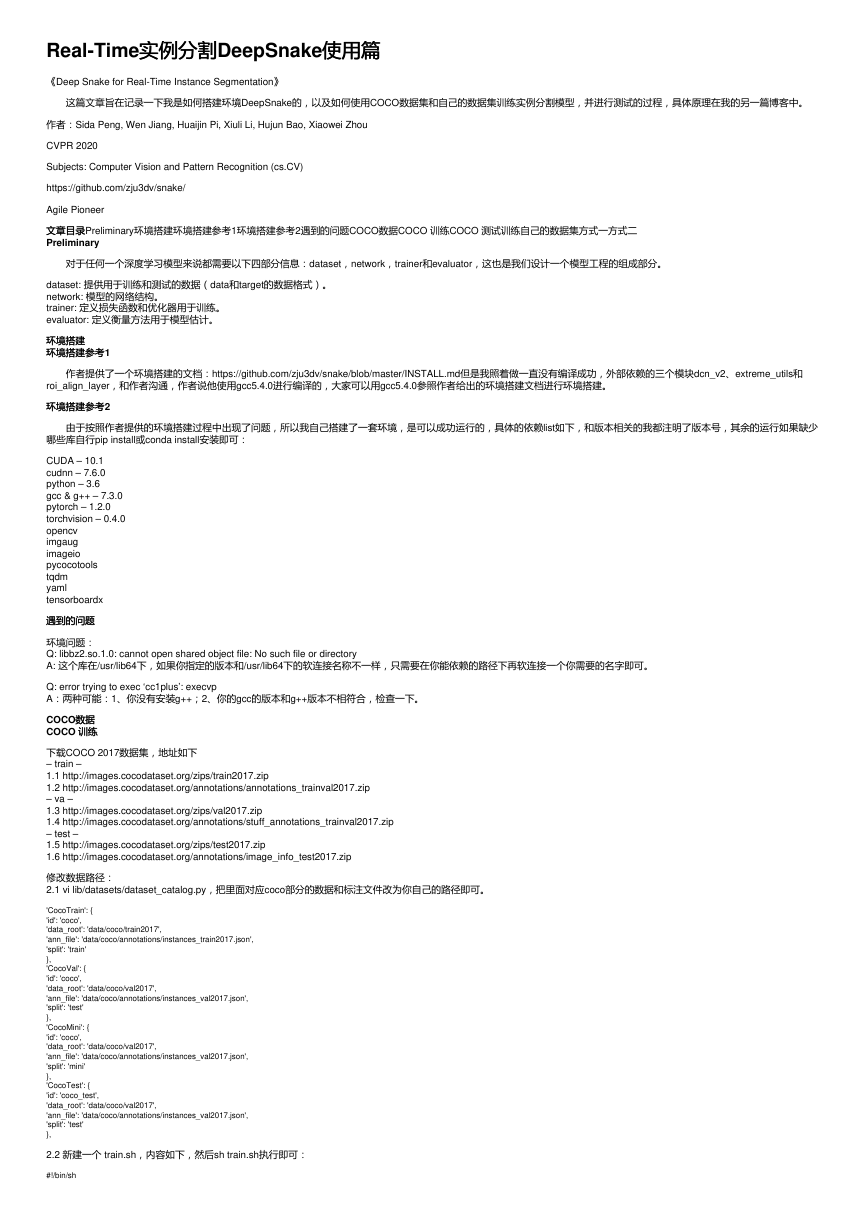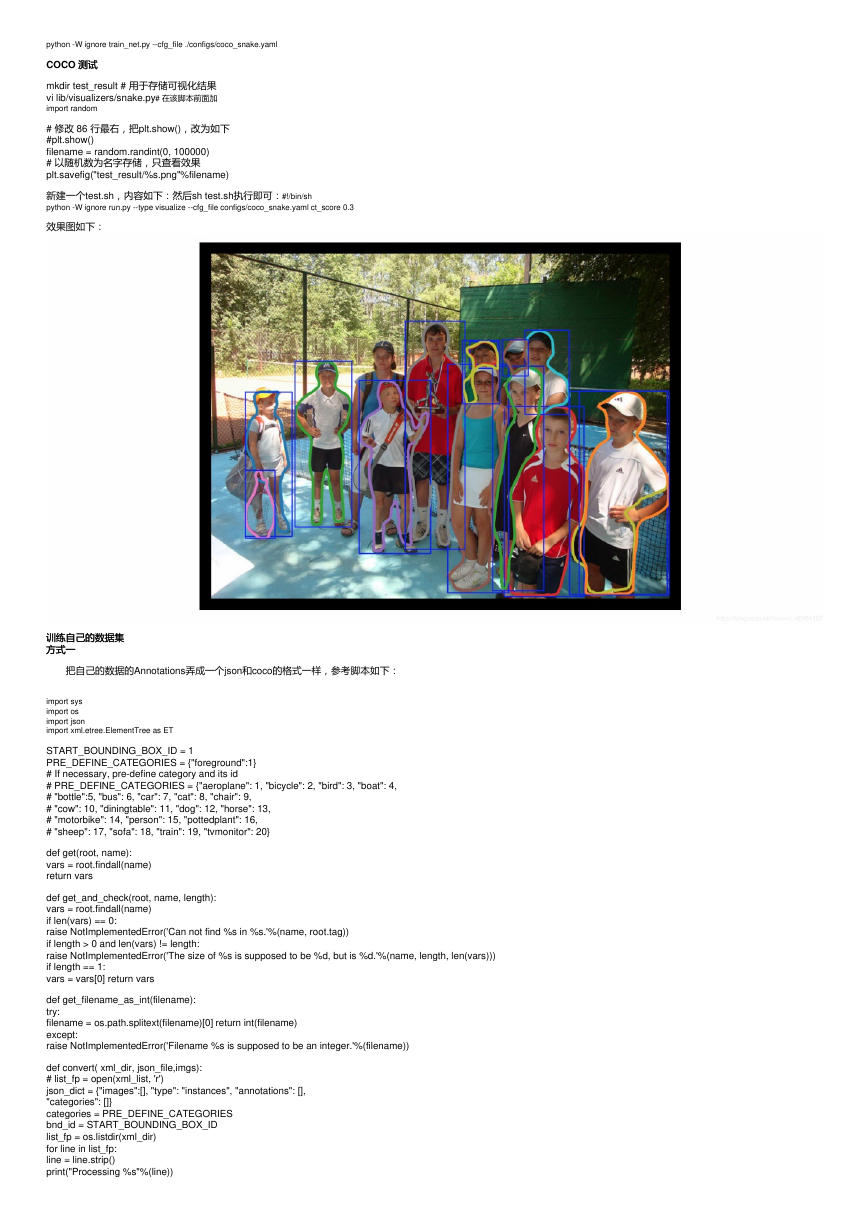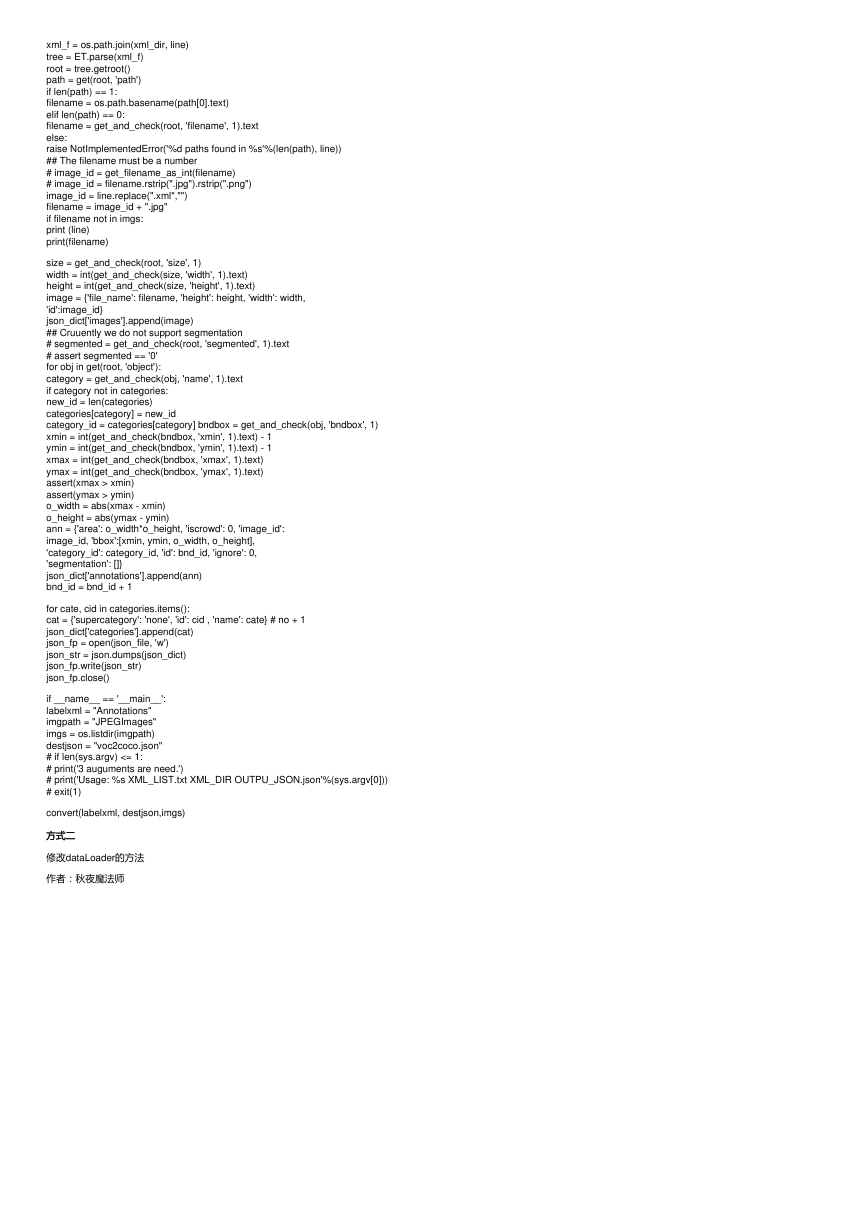Real-Time实例分割
实例分割DeepSnake使用篇使用篇
《Deep Snake for Real-Time Instance Segmentation》
这篇文章旨在记录一下我是如何搭建环境DeepSnake的,以及如何使用COCO数据集和自己的数据集训练实例分割模型,并进行测试的过程,具体原理在我的另一篇博客中。
作者:Sida Peng, Wen Jiang, Huaijin Pi, Xiuli Li, Hujun Bao, Xiaowei Zhou
CVPR 2020
Subjects: Computer Vision and Pattern Recognition (cs.CV)
https://github.com/zju3dv/snake/
Agile Pioneer
文章目录Preliminary环境搭建环境搭建参考1环境搭建参考2遇到的问题COCO数据COCO 训练COCO 测试训练自己的数据集方式一方式二
文章目录
Preliminary
对于任何一个深度学习模型来说都需要以下四部分信息:dataset,network,trainer和evaluator,这也是我们设计一个模型工程的组成部分。
dataset: 提供用于训练和测试的数据(data和target的数据格式)。
network: 模型的网络结构。
trainer: 定义损失函数和优化器用于训练。
evaluator: 定义衡量方法用于模型估计。
环境搭建
环境搭建
环境搭建参考1
环境搭建参考
作者提供了一个环境搭建的文档:https://github.com/zju3dv/snake/blob/master/INSTALL.md但是我照着做一直没有编译成功,外部依赖的三个模块dcn_v2、extreme_utils和
roi_align_layer,和作者沟通,作者说他使用gcc5.4.0进行编译的,大家可以用gcc5.4.0参照作者给出的环境搭建文档进行环境搭建。
环境搭建参考2
环境搭建参考
由于按照作者提供的环境搭建过程中出现了问题,所以我自己搭建了一套环境,是可以成功运行的,具体的依赖list如下,和版本相关的我都注明了版本号,其余的运行如果缺少
哪些库自行pip install或conda install安装即可:
CUDA – 10.1
cudnn – 7.6.0
python – 3.6
gcc & g++ – 7.3.0
pytorch – 1.2.0
torchvision – 0.4.0
opencv
imgaug
imageio
pycocotools
tqdm
yaml
tensorboardx
遇到的问题
遇到的问题
环境问题:
Q: libbz2.so.1.0: cannot open shared object file: No such file or directory
A: 这个库在/usr/lib64下,如果你指定的版本和/usr/lib64下的软连接名称不一样,只需要在你能依赖的路径下再软连接一个你需要的名字即可。
Q: error trying to exec ‘cc1plus’: execvp
A:两种可能:1、你没有安装g++;2、你的gcc的版本和g++版本不相符合,检查一下。
COCO数据数据
COCO 训练训练
下载COCO 2017数据集,地址如下
– train –
1.1 http://images.cocodataset.org/zips/train2017.zip
1.2 http://images.cocodataset.org/annotations/annotations_trainval2017.zip
– va –
1.3 http://images.cocodataset.org/zips/val2017.zip
1.4 http://images.cocodataset.org/annotations/stuff_annotations_trainval2017.zip
– test –
1.5 http://images.cocodataset.org/zips/test2017.zip
1.6 http://images.cocodataset.org/annotations/image_info_test2017.zip
修改数据路径:
2.1 vi lib/datasets/dataset_catalog.py,把里面对应coco部分的数据和标注文件改为你自己的路径即可。
'CocoTrain': {
'id': 'coco',
'data_root': 'data/coco/train2017',
'ann_file': 'data/coco/annotations/instances_train2017.json',
'split': 'train'
},
'CocoVal': {
'id': 'coco',
'data_root': 'data/coco/val2017',
'ann_file': 'data/coco/annotations/instances_val2017.json',
'split': 'test'
},
'CocoMini': {
'id': 'coco',
'data_root': 'data/coco/val2017',
'ann_file': 'data/coco/annotations/instances_val2017.json',
'split': 'mini'
},
'CocoTest': {
'id': 'coco_test',
'data_root': 'data/coco/val2017',
'ann_file': 'data/coco/annotations/instances_val2017.json',
'split': 'test'
},
2.2 新建一个 train.sh,内容如下,然后sh train.sh执行即可:
#!/bin/sh
�
python -W ignore train_net.py --cfg_file ./configs/coco_snake.yaml
COCO 测试测试
mkdir test_result # 用于存储可视化结果
vi lib/visualizers/snake.py# 在该脚本前面加
import random
# 修改 86 行最右,把plt.show(),改为如下
#plt.show()
filename = random.randint(0, 100000)
# 以随机数为名字存储,只查看效果
plt.savefig("test_result/%s.png"%filename)
新建一个test.sh,内容如下:然后sh test.sh执行即可:#!/bin/sh
python -W ignore run.py --type visualize --cfg_file configs/coco_snake.yaml ct_score 0.3
效果图如下:
训练自己的数据集
训练自己的数据集
方式一方式一
把自己的数据的Annotations弄成一个json和coco的格式一样,参考脚本如下:
import sys
import os
import json
import xml.etree.ElementTree as ET
START_BOUNDING_BOX_ID = 1
PRE_DEFINE_CATEGORIES = {"foreground":1}
# If necessary, pre-define category and its id
# PRE_DEFINE_CATEGORIES = {"aeroplane": 1, "bicycle": 2, "bird": 3, "boat": 4,
# "bottle":5, "bus": 6, "car": 7, "cat": 8, "chair": 9,
# "cow": 10, "diningtable": 11, "dog": 12, "horse": 13,
# "motorbike": 14, "person": 15, "pottedplant": 16,
# "sheep": 17, "sofa": 18, "train": 19, "tvmonitor": 20}
def get(root, name):
vars = root.findall(name)
return vars
def get_and_check(root, name, length):
vars = root.findall(name)
if len(vars) == 0:
raise NotImplementedError('Can not find %s in %s.'%(name, root.tag))
if length > 0 and len(vars) != length:
raise NotImplementedError('The size of %s is supposed to be %d, but is %d.'%(name, length, len(vars)))
if length == 1:
vars = vars[0] return vars
def get_filename_as_int(filename):
try:
filename = os.path.splitext(filename)[0] return int(filename)
except:
raise NotImplementedError('Filename %s is supposed to be an integer.'%(filename))
def convert( xml_dir, json_file,imgs):
# list_fp = open(xml_list, 'r')
json_dict = {"images":[], "type": "instances", "annotations": [],
"categories": []}
categories = PRE_DEFINE_CATEGORIES
bnd_id = START_BOUNDING_BOX_ID
list_fp = os.listdir(xml_dir)
for line in list_fp:
line = line.strip()
print("Processing %s"%(line))
�
xml_f = os.path.join(xml_dir, line)
tree = ET.parse(xml_f)
root = tree.getroot()
path = get(root, 'path')
if len(path) == 1:
filename = os.path.basename(path[0].text)
elif len(path) == 0:
filename = get_and_check(root, 'filename', 1).text
else:
raise NotImplementedError('%d paths found in %s'%(len(path), line))
## The filename must be a number
# image_id = get_filename_as_int(filename)
# image_id = filename.rstrip(".jpg").rstrip(".png")
image_id = line.replace(".xml","")
filename = image_id + ".jpg"
if filename not in imgs:
print (line)
print(filename)
size = get_and_check(root, 'size', 1)
width = int(get_and_check(size, 'width', 1).text)
height = int(get_and_check(size, 'height', 1).text)
image = {'file_name': filename, 'height': height, 'width': width,
'id':image_id}
json_dict['images'].append(image)
## Cruuently we do not support segmentation
# segmented = get_and_check(root, 'segmented', 1).text
# assert segmented == '0'
for obj in get(root, 'object'):
category = get_and_check(obj, 'name', 1).text
if category not in categories:
new_id = len(categories)
categories[category] = new_id
category_id = categories[category] bndbox = get_and_check(obj, 'bndbox', 1)
xmin = int(get_and_check(bndbox, 'xmin', 1).text) - 1
ymin = int(get_and_check(bndbox, 'ymin', 1).text) - 1
xmax = int(get_and_check(bndbox, 'xmax', 1).text)
ymax = int(get_and_check(bndbox, 'ymax', 1).text)
assert(xmax > xmin)
assert(ymax > ymin)
o_width = abs(xmax - xmin)
o_height = abs(ymax - ymin)
ann = {'area': o_width*o_height, 'iscrowd': 0, 'image_id':
image_id, 'bbox':[xmin, ymin, o_width, o_height],
'category_id': category_id, 'id': bnd_id, 'ignore': 0,
'segmentation': []}
json_dict['annotations'].append(ann)
bnd_id = bnd_id + 1
for cate, cid in categories.items():
cat = {'supercategory': 'none', 'id': cid , 'name': cate} # no + 1
json_dict['categories'].append(cat)
json_fp = open(json_file, 'w')
json_str = json.dumps(json_dict)
json_fp.write(json_str)
json_fp.close()
if __name__ == '__main__':
labelxml = "Annotations"
imgpath = "JPEGImages"
imgs = os.listdir(imgpath)
destjson = "voc2coco.json"
# if len(sys.argv) <= 1:
# print('3 auguments are need.')
# print('Usage: %s XML_LIST.txt XML_DIR OUTPU_JSON.json'%(sys.argv[0]))
# exit(1)
convert(labelxml, destjson,imgs)
方式二方式二
修改dataLoader的方法
作者:秋夜魔法师
�






 2023年江西萍乡中考道德与法治真题及答案.doc
2023年江西萍乡中考道德与法治真题及答案.doc 2012年重庆南川中考生物真题及答案.doc
2012年重庆南川中考生物真题及答案.doc 2013年江西师范大学地理学综合及文艺理论基础考研真题.doc
2013年江西师范大学地理学综合及文艺理论基础考研真题.doc 2020年四川甘孜小升初语文真题及答案I卷.doc
2020年四川甘孜小升初语文真题及答案I卷.doc 2020年注册岩土工程师专业基础考试真题及答案.doc
2020年注册岩土工程师专业基础考试真题及答案.doc 2023-2024学年福建省厦门市九年级上学期数学月考试题及答案.doc
2023-2024学年福建省厦门市九年级上学期数学月考试题及答案.doc 2021-2022学年辽宁省沈阳市大东区九年级上学期语文期末试题及答案.doc
2021-2022学年辽宁省沈阳市大东区九年级上学期语文期末试题及答案.doc 2022-2023学年北京东城区初三第一学期物理期末试卷及答案.doc
2022-2023学年北京东城区初三第一学期物理期末试卷及答案.doc 2018上半年江西教师资格初中地理学科知识与教学能力真题及答案.doc
2018上半年江西教师资格初中地理学科知识与教学能力真题及答案.doc 2012年河北国家公务员申论考试真题及答案-省级.doc
2012年河北国家公务员申论考试真题及答案-省级.doc 2020-2021学年江苏省扬州市江都区邵樊片九年级上学期数学第一次质量检测试题及答案.doc
2020-2021学年江苏省扬州市江都区邵樊片九年级上学期数学第一次质量检测试题及答案.doc 2022下半年黑龙江教师资格证中学综合素质真题及答案.doc
2022下半年黑龙江教师资格证中学综合素质真题及答案.doc